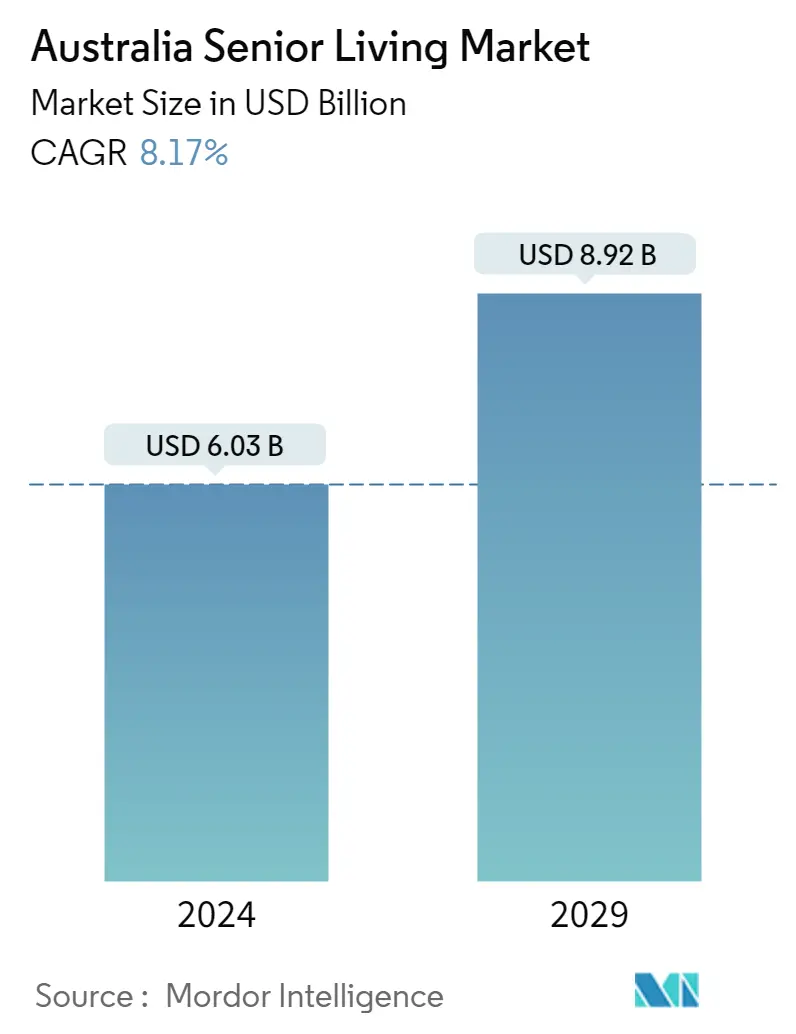Market Size of Australia Senior Living Industry

| Study Period | 2019 - 2029 |
| Base Year For Estimation | 2023 |
| Market Size (2024) | USD 6.03 Billion |
| Market Size (2029) | USD 8.92 Billion |
| CAGR (2024 - 2029) | 8.17 % |
| Market Concentration | High |
Major Players
*Disclaimer: Major Players sorted in no particular order |
Australia Senior Living Market Analysis
The Australia Senior Living Market size is estimated at USD 6.03 billion in 2024, and is expected to reach USD 8.92 billion by 2029, growing at a CAGR of 8.17% during the forecast period (2024-2029).
The housing demand from the aging population drives the market. Furthermore, the market is driven by the demand for multi-story buildings.
- The demand for senior housing has increased in Australia due to the COVID-19 pandemic. It is expected to continue to rise in the coming years, driven by a focus on health and well-being and a rapidly aging population. Real estate developers respond to this demand by constructing standalone senior living projects or dedicated towers with necessary amenities for senior citizens within a larger group housing project.
- According to the Property Council of Australia's 2021 Retirement Living Census, multi-story buildings are becoming more common in retirement villages. According to the report, 41% of new towns in 2020-21 were classified as 'vertical' in nature, up from 33% in 2020. Furthermore, retirees are increasingly seeking locations near the bustling, vibrant urban village ton access restaurants, shopping malls, and arts and cultural opportunities.
- Land in and around these areas is frequently set aside for higher-density living, taken advantage of by retirement village developers. As of 2022, 13 higher-density projects are currently under construction or have recently been completed, given the strong trend toward vertical retirement villages. Some projects feature multimillion-dollar apartments, while others have units for under USD 300,000.
Australia Senior Living Industry Segmentation
Senior living is a concept that refers to various housing and lifestyle options for senior citizens that are adapted to the challenges of aging, such as limited mobility and susceptibility to illness. A complete background analysis of the Australia Senior Living Market, including the assessment of the economy and contribution of sectors in the economy, market overview, market size estimation for key segments, and emerging trends in the market segments, market dynamics, and geographical trends, and COVID-19 impact is included in the report.
The Australian senior living market is segmented by property type (assisted living, independent living, memory care, and nursing care) and by cities (Sunshine Coast, Hobart, Melbourne, Perth, South Coast, and Other Cities). The report offers market size and forecasts in value (USD) for all the above segments.
| By Property Type | |
| Assisted Living | |
| Independent Living | |
| Memory Care | |
| Nursing Care |
| By Cities | |
| Sunshine Coast | |
| Hobart | |
| Melbourne | |
| Perth | |
| South Coast | |
| Other Cities |
Australia Senior Living Market Size Summary
The Australian senior living market is experiencing significant growth, driven by the increasing demand for housing solutions catering to the aging population. This demand is further fueled by the trend towards multi-story buildings, as more retirees seek vibrant urban locations that offer easy access to amenities such as restaurants, shopping, and cultural activities. The COVID-19 pandemic has accelerated the need for senior housing, prompting real estate developers to respond by constructing dedicated senior living projects and integrating necessary amenities within larger housing developments. The market is characterized by a shift towards higher-density living, with a notable increase in vertical retirement villages, reflecting the changing preferences of retirees.
The market landscape is relatively fragmented, with key players like Stockland, Lendlease, and Oak Tree Group leading the charge. The ongoing development of new housing projects and retirement villages is expected to further intensify market fragmentation, as new entrants seek to capitalize on the growing demand. Recent investments and expansions, such as Aware Super's acquisition of a stake in Oak Tree Retirement Villages and Lendlease's development of new independent villas, highlight the dynamic nature of the market. As the proportion of older Australians continues to rise, the senior living market is poised for continued expansion, supported by advancements in healthcare technology and a focus on enhancing the quality of life for seniors.
Australia Senior Living Market Size - Table of Contents
-
1. MARKET DYNAMICS AND INSIGHTS
-
1.1 Market Overview
-
1.2 Market Dynamics
-
1.2.1 Market Drivers
-
1.2.1.1 Aging Population
-
1.2.1.2 Increased Longevity
-
-
1.2.2 Market Restraints
-
1.2.2.1 Inadequate Staffing
-
-
1.2.3 Market Opportunities
-
1.2.3.1 Changing Care Preferences
-
-
-
1.3 Industry Attractiveness - Porter's Five Forces Analysis
-
1.3.1 Bargaining Power of Suppliers
-
1.3.2 Bargaining Power of Buyers/Consumers
-
1.3.3 Threat of New Entrants
-
1.3.4 Threat of Substitute Products
-
1.3.5 Intensity of Competitive Rivalry
-
-
1.4 Value Chain/Supply Chain Analysis
-
1.5 Impact of Government Regulations and Initiatives on the Industry
-
1.6 Technological Innovations in the Senior Living Market
-
1.7 Insights into Senior Living Construction Costs
-
1.8 Insights into Investments in Senior Living
-
1.9 Impact of COVID-19 on the Market
-
-
2. MARKET SEGMENTATION
-
2.1 By Property Type
-
2.1.1 Assisted Living
-
2.1.2 Independent Living
-
2.1.3 Memory Care
-
2.1.4 Nursing Care
-
-
2.2 By Cities
-
2.2.1 Sunshine Coast
-
2.2.2 Hobart
-
2.2.3 Melbourne
-
2.2.4 Perth
-
2.2.5 South Coast
-
2.2.6 Other Cities
-
-
Australia Senior Living Market Size FAQs
How big is the Australia Senior Living Market?
The Australia Senior Living Market size is expected to reach USD 6.03 billion in 2024 and grow at a CAGR of 8.17% to reach USD 8.92 billion by 2029.
What is the current Australia Senior Living Market size?
In 2024, the Australia Senior Living Market size is expected to reach USD 6.03 billion.

